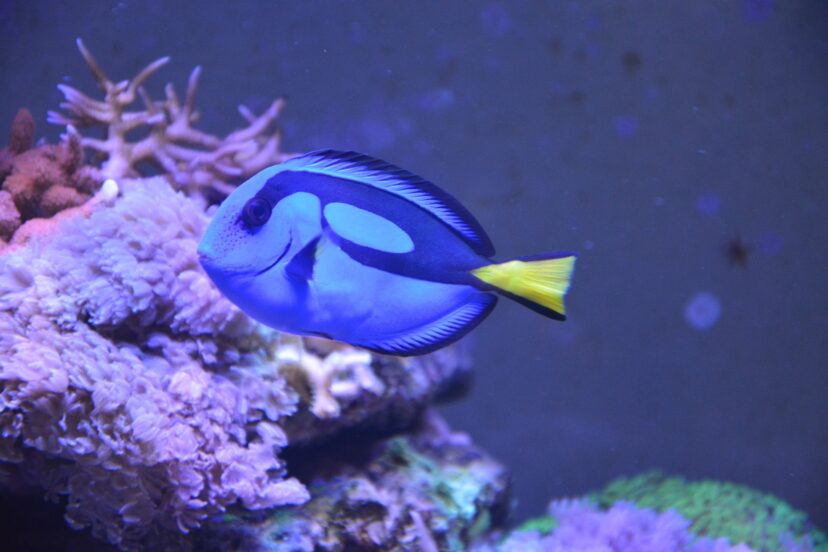Tang Fish
1. Introduction to Tang Fish
1.1. Overview of Yellow and Blue Tang Fish

Yellow tang fish and blue tang fish are vibrant and popular inhabitants of tropical saltwater aquariums. The yellow tang, known scientifically as Zebrasoma flavescens, is renowned for its stunning, bright yellow hue. It primarily inhabits the Pacific Ocean, especially around Hawaii.
On the other hand, the blue tang fish, or Paracanthurus hepatus, is famous for its vivid blue body and striking yellow tail, commonly found in the Indo-Pacific region. Both species are prized for their beauty and are key in maintaining the health of coral reefs, making them both fascinating and ecologically significant.
2. Understanding Yellow Tangs
2.1. Appearance and Characteristics
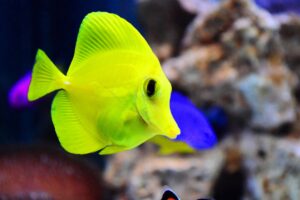
Yellow tangs are easily recognizable by their intense, uniform yellow color and oval-shaped bodies, typically growing up to 8 inches in length. They possess a sharp, retractable spine near the tail, used for defense. Blue tangs, on the other hand, exhibit a deep blue body with a distinctive yellow tail and black palette design. They can grow up to 12 inches and are known for their laterally compressed bodies and sharp caudal spines, which they use for protection.
2.2. Habitat and Distribution
Yellow tangs are predominantly found in shallow, coral-rich areas of the Pacific Ocean, with a significant population around Hawaii. They thrive in clear, sunlit waters, usually at depths ranging from 2 to 46 meters. Blue tangs inhabit a wider range, from the East Coast of Africa to the Caribbean. They prefer coral reefs and lagoon waters, usually at depths of 2 to 40 meters. Both species play a vital role in reef ecosystems, contributing to the health and diversity of these habitats.
3. Diving into the World of Blue Tangs

3.1. Appearance and Characteristics
Yellow tang fish boast a radiant, lemon-yellow coloration and an oval, laterally compressed body shape, typically growing up to 8 inches. Their distinctive feature includes a sharp, retractable spine near the tail, used for defense. Blue tang fish, on the other hand, display a striking cobalt blue body contrasted with a vibrant yellow tail. They can reach up to 12 inches in length, characterized by their streamlined body and a prominent, sharp spine on the tail, which serves as their defense mechanism.
3.2. Natural Habitat
Yellow tang fish predominantly inhabit the coral-rich, shallow waters of the Pacific Ocean, especially around the Hawaiian Islands. They are commonly found in reef environments, thriving in clear, sunlit waters at depths of 2 to 46 meters. Blue tang fish have a wider geographical range, spanning from the Indo-Pacific to the Eastern Pacific regions. Their preferred habitats are coral reefs and lagoon waters, often at depths ranging from 2 to 40 meters. These habitats provide them with ample food sources and shelter, essential for their survival and wellbeing.
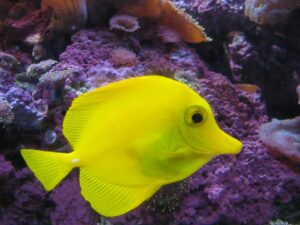
4. Caring for Tangs in Home Aquariums
4.1. Tank Requirements
For yellow and blue tangs, a spacious tank is essential, ideally 100 gallons or more, to provide ample swimming space. The tank should mimic their natural coral-rich habitat, featuring live rocks and plenty of hiding spots. Stable water conditions are crucial, with a temperature range of 75-80°F, a pH level between 8.1 and 8.4, and specific gravity of 1.020-1.026. Good filtration and regular water changes are necessary to maintain water quality, ensuring a healthy environment for these sensitive species.
4.2. Diet and Nutrition
Both yellow and blue tangs require a diet rich in marine algae, which is crucial for their health and coloration. They can be fed with high-quality commercial marine algae, spirulina, and seaweed sheets. Supplementing their diet with occasional meaty foods like brine shrimp or mysis shrimp provides essential proteins. It’s important to feed them small amounts several times a day to mimic their natural grazing behavior, ensuring they receive adequate nutrition without overfeeding.
4.3. Health and Well-being
Maintaining the health of yellow and blue tangs involves regular monitoring for signs of stress or disease, such as changes in color, appetite, or activity levels. They are prone to common saltwater fish diseases, including ich and marine velvet. A quarantine tank is recommended for new additions to prevent the spread of diseases. Providing a stress-free environment with stable water conditions, a balanced diet, and compatible tank mates is key to ensuring their long-term health and well-being.
5. Behavioral Aspects of Tangs
5.1.Social Behavior
Yellow tang fish and blue tang fish exhibit distinct social behaviors in aquarium settings. Yellow tang fish can be territorial, especially towards members of their own species or similar-looking fish. It’s crucial to provide them with adequate space and hiding places to minimize aggression. Blue tang fish, while also territorial, tend to be more sociable and can adapt well to community tanks. Both species exhibit hierarchical behaviors and can become more assertive when establishing dominance, making careful observation of their interactions important for a harmonious tank.
5.2. Compatibility with Other Fish
In terms of compatibility, yellow tang fish and blue tang fish can coexist with a variety of other marine fish, provided the tank is sufficiently large and well-structured with hiding spaces. They generally do well with non-aggressive species and should be housed with fish that don’t compete for similar food and space. Avoid pairing them with aggressive species or those with similar body shapes and colors to prevent territorial disputes. With thoughtful selection of tank mates, these tangs can be part of a vibrant and diverse marine aquarium community.
6. Breeding Tang Fish
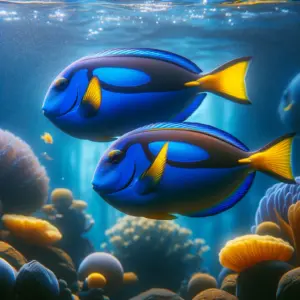
6.1. Breeding Conditions
Breeding yellow and blue tangs in captivity requires specific conditions and careful planning. A separate breeding tank with controlled environmental conditions is essential. The water quality needs to be pristine, with stable temperature and pH levels mimicking their natural habitat. Providing ample space is crucial, as tangs need room for courtship behaviors. Additionally, replicating natural light cycles and providing a varied, nutritious diet can encourage breeding behavior. For successful breeding, understanding their specific mating rituals and environmental cues is vital.
6.2. Challenges in Breeding
Breeding yellow and blue tangs presents several challenges. First, distinguishing males from females can be difficult, as they lack obvious sexual dimorphism. This makes pairing for breeding a challenge. Additionally, tangs are broadcast spawners in the wild, releasing eggs and sperm into the water column, a behavior difficult to replicate in captivity. The survival rate of fry is also low due to their specific larval rearing requirements. Ensuring proper nutrition and avoiding predation in the early stages of life further complicates breeding efforts in a home aquarium.
7. How to successfully breed Yellow Tang Fish
Successfully breeding Yellow Tangs in captivity is a complex and challenging task, but with the right approach and conditions, it can be achieved. Here are key steps to increase your chances of success:
7.1. Establish a Suitable Breeding Environment:
Set up a dedicated breeding tank, ideally larger than the regular tank, to provide ample space for mating behaviors. The tank should mimic the natural habitat of Yellow Tangs, with a stable temperature around 75-80°F, a pH level between 8.1 and 8.4, and specific gravity of 1.020-1.026. Include live rocks and places for hiding and spawning.
7.2.Identify Breeding Pairs:
Distinguishing males from females is tricky, as Yellow Tang Fish don’t show significant sexual dimorphism. Observing their behavior can provide clues, as males may display more assertive courting behaviors. It’s often a trial-and-error process to form a breeding pair.
7.3. Optimize Water Quality:
Consistent and pristine water conditions are crucial. Regularly monitor and maintain water parameters, ensuring low nitrate and ammonia levels. Good filtration and frequent water changes are essential.
7.4. Provide a Balanced Diet:
Offer a varied diet rich in marine algae, spirulina, and supplemented with high-quality protein sources like mysis shrimp. A nutritious diet enhances overall health and can stimulate breeding behaviors.
7.5 Mimic Natural Conditions:
Replicating natural light cycles and providing a stress-free environment can encourage spawning. Some breeders attempt to simulate seasonal changes in lighting and temperature that occur in their natural habitat.
7.6. Monitor for Spawning Signs:
Watch for changes in behavior, such as increased territoriality, vibrant coloration, or the male and female swimming together more frequently. Spawning often occurs at dawn or dusk.
7.7. Manage Egg and Fry Care:
If spawning occurs, the fertilized eggs will need careful management. In the wild, eggs are released into the water column. In captivity, they need to be protected from being eaten or damaged by filtration systems.
7.8..Rearing:
Raising the larvae presents significant challenges due to their small size and specific dietary needs. They require microscopic food sources like rotifers initially, gradually transitioning to larger foods as they grow.
7.9. Prepare for High Mortality Rates:
Be prepared for high mortality rates in the early stages. Survival rates for tang fry are typically low due to their delicate nature and specific requirements.
7.1.1.Patience and Persistence:
Breeding Yellow Tang Fish requires patience and persistence. It’s a long-term commitment, and success may not come immediately. Continuous learning and adaptation of techniques based on observations and experiences are key.
Remember, breeding Yellow Tang Fish in a home aquarium is an advanced endeavor, often pursued by experienced aquarists or professional breeders. It requires dedication, extensive knowledge of marine biology, and a willingness to learn from trial and error.
8. How to successfully breed Blue Tang Fish.
Successfully breeding Blue Tangs (Paracanthurus hepatus) in a home aquarium is a challenging and seldom-accomplished task, typically more feasible for experienced aquarists or professional breeders. However, if you’re determined to try, here are some steps and considerations to increase your chances of success:
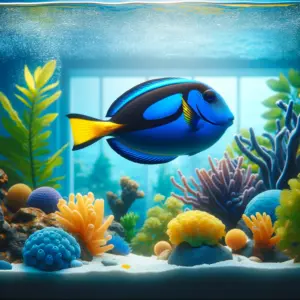
8.1. Create the Right Environment:
Set up a dedicated, large breeding tank separate from the community aquarium. Blue Tangs need a lot of space, so a tank of at least 150-200 gallons is recommended. The tank should mimic their natural reef environment, with plenty of live rock and hiding places.
8.2. Optimal Water Conditions:
Maintain pristine water quality with stable parameters. The temperature should be around 75-80°F (24-27°C), with a pH level between 8.1 and 8.4 and specific gravity of 1.020-1.026. Regular water testing and changes are essential.
8.3. Identifying Mating Pairs:
Blue Tang Fish do not exhibit prominent sexual dimorphism, making it difficult to distinguish males from females. Observation of their behavior might provide clues, as mating pairs often display distinct courtship behaviors.
8.4. Diet and Nutrition:
Feed them a varied and high-quality diet rich in marine algae, seaweed, and occasional meaty foods like mysis shrimp. A nutritious diet is crucial for their health and to encourage breeding behaviors.
8.5. Simulate Natural Breeding Cycles:
Try to replicate the natural conditions that trigger spawning in the wild. This might include adjusting lighting to mimic seasonal changes and potentially altering water temperatures slightly to simulate different seasons.
8.6. Monitor for Spawning Behavior:
Blue Tangs are broadcast spawners, releasing eggs and sperm into the water column. Watch for signs of spawning, such as the fish swimming in unison near the surface.
8.7. Larval Care:
If spawning is successful, the larvae will need specialized care. They require microscopic food sources like rotifers initially, then can be transitioned to larger food types as they grow.
8.8. Managing Fry:
The fry are extremely delicate and require stable water conditions and appropriate food. Survival rates can be low, and the process is labor-intensive.
8.9. Be Prepared for Challenges:
Breeding Blue Tangs comes with significant challenges, including a high risk of disease and the difficulty of raising the fry due to their tiny size and specific requirements.
8.1.1. Patience and Commitment:
Successful breeding requires patience, dedication, and a willingness to learn and adapt. Don’t be discouraged by initial failures; breeding Blue Tangs is a learning process.
Breeding Blue Tangs is an ambitious project, often more suited for research facilities or professional breeding setups due to the complex requirements and low success rates. However, with the right knowledge, resources, and commitment, it can be a rewarding challenge for a dedicated hobbyist.
9. Environmental Importance of Tang Fish
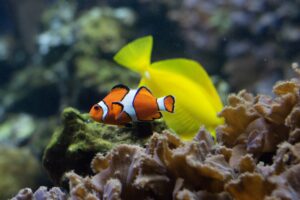
9.1. Role in the Ecosystem of Tang Fish
Yellow and blue tang fish play crucial roles in marine ecosystems, particularly in coral reef health. The yellow tang, primarily a herbivore, helps control algae growth on reefs, preventing overgrowth that can suffocate corals. Similarly, blue tangs, also herbivores, graze on algae, aiding in maintaining the balance between coral and algae. This grazing activity is vital for the health and sustainability of reef ecosystems, ensuring their biodiversity and resilience against environmental changes.
9.2. Conservation Status of Tang Fish
The conservation status of yellow and blue tang fish has raised concerns due to their popularity in the aquarium trade. The yellow tang, while not currently listed as endangered, faces threats from overharvesting for aquariums. Blue tangs, famously known from the movie “Finding Nemo,” also face similar pressures. Their collection often involves harmful practices like cyanide fishing, which damages reefs and other marine life. Efforts are ongoing to promote sustainable practices and breeding programs to alleviate the pressure on wild populations and preserve these species for future generations.
10. Practical Tips for Tang Fish Enthusiasts
10.1. Choosing the Right Tang Fish
Selecting the right tang for your aquarium is crucial for its well-being and your enjoyment. Consider the size of your tank; yellow and blue tangs need ample space to swim and thrive. Assess the tang’s health in the store – look for bright eyes, vibrant color, and active swimming. Also, consider the tang’s compatibility with your existing tank inhabitants. Research the specific needs of each species, as yellow tangs can be more territorial, while blue tangs are generally more sociable but sensitive.
10.2. Common Mistakes to Avoid with Tang Fish
When keeping tangs, common mistakes include underestimating tank size and overstocking, leading to stress and aggression. Neglecting water quality is another critical error; tangs require stable, clean water conditions. Overfeeding or providing an incorrect diet can lead to health issues. Avoid introducing tangs to an unestablished tank, as they thrive in mature, stable environments. Lastly, not quarantining new fish can introduce diseases. Being aware of these pitfalls is key to successfully keeping healthy and happy tangs. Always have a spare tank available for sick or spawning fish.
11. Personal Experiences with Tang Fish
11.1. Stories and Anecdotes
My journey with tangs has been filled with enchantment and learning. I recall the day I introduced my first yellow tang to the tank. Its immediate exploration and adaptation to the new environment was a sight to behold. Then came the addition of a blue tang, which brought a new dynamic. Watching them establish territories yet coexist peacefully was fascinating. One memorable moment was witnessing their unique feeding dance during meal times, a harmonious ballet that never ceases to amaze me. These experiences have not only deepened my understanding but also my appreciation for these magnificent creatures and their complex behaviors.
12. Conclusion
12.1. Summary and Final Thoughts
My journey with yellow and blue tang fish has been an enlightening and joyous chapter in my aquarist life. These stunning creatures, with their vibrant colors and unique personalities, have not only beautified my tank but also taught me invaluable lessons about marine life and its intricacies. Their importance in the ecosystem, coupled with the challenges they face, highlights the need for responsible fishkeeping and conservation. The experience of nurturing these tangs serves as a reminder of the delicate balance in our oceans and the role we can play in preserving it. They are truly a treasure of the aquatic world.
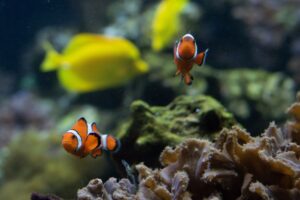
You might also like to learn more about these fish:
Just follow the link…
Types of Clownfish
Clownfish Eggs
Cardinal Fish
Wrasses
Butterfky Fish
FAQs
1. What size tank do I need for yellow and blue tangs?
You should provide at least a 100-gallon tank for yellow tangs and a larger one for blue tangs, preferably around 150-200 gallons. These sizes ensure enough space for their active swimming and well-being.
2. Can yellow and blue tang fish live together?
Yes, yellow and blue tang fish can coexist in the same tank. It’s important to monitor their interactions, as both can be territorial. Ensure your tank is large enough and has plenty of hiding spots to reduce potential conflicts.
3. What should I feed my tangs to keep them healthy?
Feed your tangs a diet rich in marine algae and seaweeds. Supplement this with occasional meaty foods like mysis shrimp. Ensure frequent, small feedings to mimic their natural grazing habits.
4. How do I know if my tangs are healthy?
Healthy tangs display vibrant colors, active swimming, and a good appetite. Watch for signs of stress or illness, such as faded colors, lethargy, or lack of eating, and address any water quality or compatibility issues immediately.
5. Are tang fish suitable for beginner aquarists?
Tangs can be a challenge for beginners due to their specific tank and dietary requirements. However, if you’re committed to learning and providing the right environment, they can be a rewarding addition to your aquarium.
Mates for Tang Fish in your Aquarium.
When considering tank mates for tangs, such as yellow and blue tang fish, it’s important to choose fish that are compatible in terms of temperament, size, and environmental needs. Here are some suitable options:
1. Clownfish:
These are peaceful and can coexist well with tangs. They usually keep to themselves or host in anemones, thus not intruding on the tangs’ space.
2. Dwarf Angelfish:
While some angelfish can be territorial, smaller varieties like the Flame Angelfish are often good companions for tangs in larger tanks.
3. Gobies and Blennies:
These bottom-dwellers are generally peaceful and occupy a different tank region than tangs, reducing potential conflicts.
4. Cardinalfish:
Known for their peaceful nature, they are great community fish and can coexist with tangs without issues.
5. Wrasses:
Many wrasse species, like the Fairy or Cleaner wrasses, are peaceful and add dynamic activity to the tank. They also help control parasites, benefiting tangs.
6. Butterflyfish:
Certain species of butterflyfish can cohabit with tangs. It’s essential to select less aggressive varieties and ensure ample space.
7. Hawkfish:
They are generally peaceful, though some can be semi-aggressive. Choose smaller, less dominant species for a community tank.
8. Chromis:
These small, schooling fish are peaceful and active, providing movement in different areas of the tank than tangs usually occupy.
9. Large Shrimp and Snails:
Invertebrates like cleaner shrimp and various snails can also be good tank mates as they don’t compete with tangs for space or food.
When introducing new fish to a tank with tangs, it’s crucial to monitor their interactions closely, especially in the initial period, to ensure there are no signs of aggression or stress. Also, consider the size of the tank and the specific needs of each species to create a harmonious and healthy environment for all your aquatic pets.
